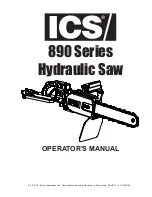
3
Tool Use and Care
12. Use clamps or other practical way to secure and
support the workpiece to a stable platform.
Hold-
ing the work by hand or against your body is unsta-
ble and may lead to loss of control.
13. Do not force tool. Use the correct tool for your
application.
The correct tool will do the job better
and safer at the rate for which it is designed.
14. Do not use tool if switch does not turn it on or
off.
A tool that cannot be controlled with the switch is
dangerous and must be repaired.
15. Disconnect battery pack from tool or place the
switch in the locked or off position before mak-
ing any adjustments, changing accessories, or
storing the tool.
Such preventive safety measures
reduce the risk of starting the tool accidentally.
16. Store idle tools out of reach of children and
other untrained persons.
Tools are dangerous in
the hands of untrained users.
17. When battery pack is not in use, keep it away
from other metal objects like: paper clips, coins,
keys, nails, screws, or other small metal objects
that can make a connection from one terminal to
another.
Shorting the battery terminals together
may cause sparks, burns, or a fire.
18. Maintain tools with care. Keep cutting tools
sharp and clean.
Properly maintained tools with
sharp cutting edge are less likely to bind and are
easier to control.
19. Check for misalignment or binding of moving
parts, breakage of parts, and any other condition
that may affect the tool’s operation. If damaged,
have the tool serviced before using.
Many acci-
dents are caused by poorly maintained tools.
20. Use only accessories that are recommended by
the manufacturer for your model.
Accessories
that may be suitable for one tool may create a risk of
injury when used on another tool.
SERVICE
21. Tool service must be performed only by qualified
repair personnel.
Service or maintenance per-
formed by unqualified personnel may result in a risk
of injury.
22. When servicing a tool, use only identical
replacement parts. Follow instructions in the
Maintenance section of this manual.
Use of unau-
thorized parts or failure to follow Maintenance
instructions may create a risk of shock or injury.
ADDITIONAL SAFETY RULES
USB030-2
DO NOT let comfort or familiarity with
product (gained from repeated use)
replace strict adherence to cordless jig
saw safety rules. If you use this tool
unsafely or incorrectly, you can suffer
serious personal injury.
1.
Hold tool by insulated gripping surfaces when
performing an operation where the cutting tool
may contact hidden wiring. Contact with a “live”
wire will make exposed metal parts of the tool
“live” and shock the operator.
2.
Be aware that this tool is always in an operating
condition, because it does not have to be
plugged into an electrical outlet.
3.
Always use safety glasses or goggles. Ordinary
eye or sun glasses are NOT safety glasses.
4.
Avoid cutting nails. Inspect for and remove all
nails from the workpiece before operation.
5.
Do not cut hollow pipe.
6.
Do not cut oversize workpiece.
7.
Check for the proper clearance beneath the
workpiece before cutting so that the blade will
not strike the floor, workbench, etc.
8.
Hold the tool firmly.
9.
Check the blade is not contacting the workpiece
before the switch is turned on.
10. Keep hands away from moving parts.
11. Do not leave the tool running. Operate the tool
only when hand-held.
12. Always switch off and wait for the blade to come
to a complete stop before removing the blade
from the workpiece.
13. Do not touch the blade or the workpiece immedi-
ately after operation; they may be extremely hot
and could burn your skin.
14. Some material contains chemicals which may be
toxic. Take caution to prevent dust inhalation
and skin contact. Follow material supplier safety
data.
SAVE THESE INSTRUCTIONS
WARNING:
MISUSE or failure to follow the safety
rules stated in this instruction manual
may cause serious personal injury.




































